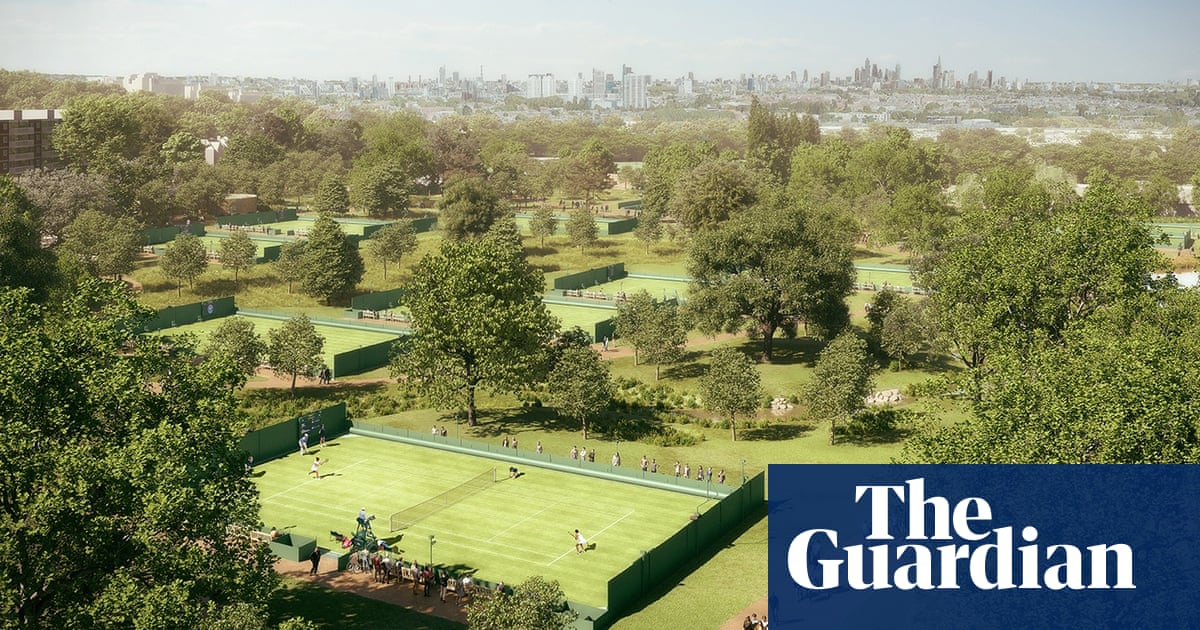
Few contests in the All England Lawn Tennis Club’s 147-year history have been as prolonged or fractious. But at City Hall on Friday the battle over plans to build 39 new courts at Wimbledon will reach a potentially decisive point.
On one side of the net stands the AELTC, which will say that the expansion is needed to ensure Wimbledon remains the world’s pre-eminent tournament. However, that is disputed by local residents’ groups and MPs, who question why Wimbledon needs to almost triple in size from 41 to 115 acres and the legality of building on metropolitan open land.
Both will present their cases to London’s deputy mayor for planning, Jules Pipe, who will be sitting in the umpire’s chair before determining whether planning permission should be granted.
Why does Wimbledon say it needs 39 extra courts?
The AELTC argues it has fallen behind the other grand slams in three areas: practice facilities, qualifying and the stature of its third show court. It wants to build an 8,000-seat show court on the grounds of the old Wimbledon Park golf club, and to use the other 38 courts for a qualifying tournament and practice facilities.
Does it believe expansion will boost spectator numbers?
Yes. Wimbledon gets about 40,000 visitors a day but the AELTC believes the new development would increase that by about 10,000. It also hopes that 10,000 fans a day may come to the qualifying tournament, which is far higher than the 2,000 capacity at the Bank of England club in Roehampton, where it is currently staged.
What is the residents’ case?
First, they maintain the expansion is not needed because Wimbledon will remain the biggest slam by virtue of its history and reputation. They also warn that the proposals will cause “corporate ecocide”, including the loss of 300 trees, as well as 10 years of disruption to the local area. Finally they say the plans will create a huge “tennis industrial complex” – with 9km of pathways, player hubs and corporate hospitality that will lie silent for much of the year.
Are there any other objections?
Yes. Fleur Anderson, the Labour MP for Putney, is among those to question the plans from a legal perspective. “Wimbledon Park is protected, Grade II-listed metropolitan open land,” she says. “This means that ‘very special circumstances’ must be proved for it to be built on.”
What is the AELTC’s response to the objections?
Unsurprisingly it rejects much of this analysis. It also points out it will plant 1,500 trees and spend £6m on silting the lake in Wimbledon Park. It says it will allow residents to play on a minimum seven courts after Wimbledon finishes until the end of the summer. It has also committed to building a boardwalk around the Wimbledon Park lake. Such moves have been welcomed by the local heritage group, who now back the scheme. However Save Wimbledon Park describes them as merely “crumbs on the table”.
How did the two sides end up at such loggerheads?
When the AELTC bought the Wimbledon Park golf course land from Merton council in 1993 for £5.2m, it also signed a covenant agreeing that it would not use the land “other than for leisure or recreational purposes or as an open space”. Some residents’ groups believe they have violated that pledge with their proposals.
Another key point in all this is that the golf club’s lease on the land was due to last until 2041, but in 2018 the AELTC offered each golf club member £85,000 to give up their club early. Unsurprisingly they accepted. The AELTC has since pushed hard to turn its expansion into reality. However, critics maintain it did little to consult residents when formulating its plans.
Why is the London mayor’s office deciding the case?
Because the land in question straddles two boroughs – one (Merton) that approved the plans last October and the other (Wandsworth) that rejected it a month later. After that it was kicked up to the mayor’s office. The deputy major is acting as umpire because Sadiq Khan has recused himself from the process after publicly expressing support for Wimbledon’s plans.
Which way is the verdict expected to go?
A decision is expected at 3pm on Friday, but Pipe does have five days to make up his mind. Most expect Wimbledon to win, especially after the Greater London Authority’s planning officers said there were “no material considerations that are considered to justify the refusal of consent”. The report also said the proposal would bring in £336m of annual benefits and “would result in the creation of 40 year-round jobs and 256 Championships jobs”.
What is the residents’ response?
Save Wimbledon Park says the GLA report contains “shallow and poorly thought-out planning analysis, which seems to have taken the AELTC views at face value”. It also noted that Richard Rees, who designed the new No 1 Court and Henman Hill between 1992-1997, is opposed to the plans.
If the AELTC wins is it game, set and match in favour of expansion?
Not entirely. The Wimbledon MP, Paul Kohler, says “all is not lost” even if the deputy mayor rules in favour of the AELTC. Kohler points to a supreme court case last year that stopped houses being built on a park protected by a 100-year-old statutory trust, and says it could apply in this case too.
Is this just classic nimbyism?
Residents insist they are not nimbies. Save Wimbledon Park’s Nick Thomas also says they like tennis at Wimbledon too. “But we object to the scale of the proposals and the entitled attitude of the club,” he says. “And the club’s notable refusal to discuss how a compromise might be reached.”
Source: theguardian.com


















